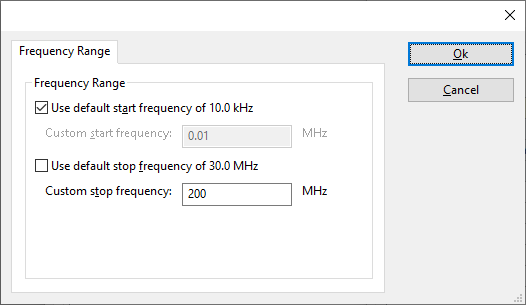Rohde & Schwarz ESHS 30
The Rohde & Schwarz ESHS 30 device driver is a Spectrum Analyser which is supported by RadiMation®.
Configuration[edit]
The following tabs are available in the advanced configuration of the Rohde & Schwarz ESHS 30:
The frequency range of the Rohde & Schwarz ESHS 30 as provided by the manufacturer is shown and selected as default. It is possible to overrule these frequencies and to manual adjust the allowed frequency range of the Rohde & Schwarz ESHS 30.
| If the checkbox is checked, the default start frequency will be used as the lowest usable frequency in a test for this device. |
| If the Use default start frequency checkbox is unchecked, another start frequency (expressed in MHz) can be specified. The customized start frequency will then be used as the lowest usable frequency in a test for this device. The customized frequency can be a limitation or an extension of the default start frequency. |
| If the checkbox is checked, the default stop frequency will be used as the highest usable frequency in a test for this device. |
| If the Use default stop frequency checkbox is unchecked, another stop frequency (expressed in MHz) can be specified. The customized stop frequency will then be used as the highest usable frequency in a test for this device. The customized frequency can be a limitation or an extension of the default stop frequency. |
Specifying a different frequency range can be useful if for example:
- A device (like a coupler, antenna, injection device, cable, etc...) is still useable (but out of specification) outside the standard suggested frequency range.
- An external mixer is used to measure an extended frequency range.
- An up- or down-convertor is used to shift the frequency range.
- A newer model of a device is present that has an extended frequency range, and still uses the same remote control commands.
Be careful changing these setting as RadiMation® is no longer able to verify if the Rohde & Schwarz ESHS 30 is used outside frequency range that is specified by the manufacturer. This may result to serious damage of your measurement device.
Related pages
Links
- Google search: Rohde & Schwarz ESHS 30
- Google image search: Rohde & Schwarz ESHS 30
| This information about an equipment is automatically generated from the list of supported device drivers from RadiMation. |
| If you need more information you can contact radimation-support@raditeq.com. |
Usage[edit]
The Rohde & Schwarz ESCS and Rohde & Schwarz ESHS receivers include a 'CISPR Bandwidths' (special) function. When this CISPR Bandwidths function is selected (turned on) The receiver itself defines which RBW values to use (based on the measured frequency). In that situation the RadiMation software cannot change the RBW values. So to allow that the end-user is able to select other RBW values in the RadiMation software, the CISPR Bandwidth selection should be turned OFF!!!
From RadiMation version 4.2.1 and higher we don't send the command to turn on or turn off this special function anymore. This means that the end-user can decide which option should be used, and he will be able to (special) function from the key-panel of the receiver. The RadiMation device driver will not change the setting of this 'CISPR Bandwidths' (special) function anymore.
The CISPR Bandwidth selection can be activated by turning on 'special function number 1'.
So to conclude:
- If special function number 1 is activated in the R&S ESHS/ESCS, the receiver itself will determine the to be used RBW (based on the measured frequency). Even if the software sets a desired RBW filter, the receiver will overrule it!
- If special function number 1 is NOT activated, the selected RBW in RadiMation will be used for the RBW during the measurement.
- RadiMation does not activate/deactivate the special function number 1 option, so the end-user himself can determine which method they want to use.
